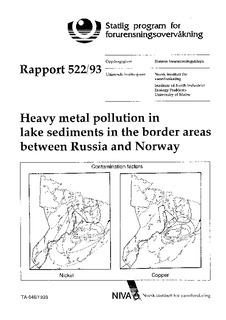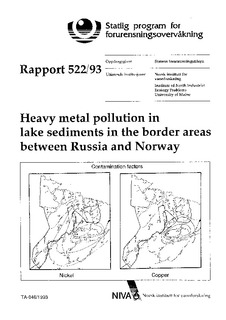| dc.contributor.author | Norton, S.A. | nb_NO |
| dc.contributor.author | Rognerud, S. | nb_NO |
| dc.contributor.author | Dauvalter, V. | nb_NO |
| dc.contributor.other | Rognerud, S. - Project manager | nb_NO |
| dc.coverage.spatial | Russland | nb_NO |
| dc.coverage.spatial | Norge | nb_NO |
| dc.date.accessioned | 2014-08-01T10:34:48Z | |
| dc.date.available | 2014-08-01T10:34:48Z | |
| dc.date.issued | 1993 | nb_NO |
| dc.identifier | 2869 | nb_NO |
| dc.identifier.isbn | 82-577-2290-1 | nb_NO |
| dc.identifier.issn | 1894-7948 | nb_NO |
| dc.identifier.uri | http://hdl.handle.net/11250/207200 | |
| dc.description.abstract | The atmosphere emissions of Ni and Cu from the smelters in Nickel and Zapoljarny are the main sources for the increased concentrations observed for these elements in young lake sediments within a distance of 30 km from the smelters. The prevailing southwestern winds are distributing the pollution plume mainly in a northeastern direction leaving the sediments in lakes more remote than 15 km southwest of Nikel almost unaffected. Co, Cu, Ni, Pb and Hg have elevated concentrations in sediment dating from the last hundred years and the onset of increased accumulation rates predates the smelting activity at Nickel and Zapoljarny. This reflects the long range transport of metals, but the maxima in accumulation rates for Co, Cu, and Ni are consistent with the history of regional smelting activities. No elevated concentrations or accumulation rates were observed for Cd and Zn except in lakes receiving runoff from slag piles located close to Nickel. Runoff from the Nickel area is also an important source of contamination for Lake Kuestsjarvi and sediments in the Pasvik River systems downstream this region. Expected ecological problems connected to heavy metal pollution of sediments on the Norwegian side of the border are mainly restricted to Ni and Cu in the Svanvik area, Pasvik River downstream the outlet from Lake Kuetsjarvi and the areas east of Pasvik River. The pollution problem is much more serious in the Russia where surface sediments in lakes between the smelters and the internationale border are seriously affected. Biological effects can be expected. | nb_NO |
| dc.description.sponsorship | Norwegian State Pollution Control Authority | nb_NO |
| dc.publisher | Norsk institutt for vannforskning | nb_NO |
| dc.relation.ispartofseries | NIVA-rapport;2869 | nb_NO |
| dc.relation.ispartofseries | Overvåkingsrapport;522/93. TA-946/1993 | nb_NO |
| dc.rights | Navngivelse-IkkeKommersiell-DelPåSammeVilkår 3.0 Norge | nb_NO |
| dc.rights.uri | http://creativecommons.org/licenses/by-nc-sa/3.0/no/ | nb_NO |
| dc.subject | miljøgifter | nb_NO |
| dc.title | Heavy metal pollution in lake sediments in the border areas between Russia and Norway | nb_NO |
| dc.type | Research report | nb_NO |
| dc.rights.holder | Norsk institutt for vannforskning/Norwegian institute for water research | nb_NO |
| dc.subject.nsi | VDP::Matematikk og naturvitenskap: 400 | nb_NO |
| dc.source.pagenumber | 18 | nb_NO |
| dc.subject.keyword | miljøgift | nb_NO |
| dc.subject.keyword | tungmetall | nb_NO |
| dc.subject.keyword | innsjøsediment | nb_NO |
| dc.subject.keyword | grenseområde luftforurensning | nb_NO |
| dc.subject.keyword | innsjø | nb_NO |
| dc.subject.keyword | forurensningsgrad | nb_NO |
| dc.subject.keyword | fordeling | nb_NO |
| dc.subject.keyword | border areas sediments ni | nb_NO |
| dc.subject.keyword | cu | nb_NO |
| dc.subject.keyword | zn | nb_NO |
| dc.subject.keyword | cd | nb_NO |
| dc.subject.keyword | and hg | nb_NO |
| dc.relation.project | O-89187 | nb_NO |


